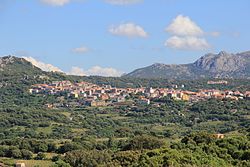Calangianus
Calangianus
Caragnani | |
|---|---|
| Comune di Calangianus | |
 Panorama | |
| Country | Italy |
| Region | Sardinia |
| Province | Sassari (SS) |
| Government | |
| • Mayor | Martino Loddo |
| Area | |
• Total | 126.5 km2 (48.8 sq mi) |
| Elevation | 518 m (1,699 ft) |
| Population (31 December 2010)[1] | |
• Total | 4,337 |
| • Density | 34/km2 (89/sq mi) |
| Demonym | Calangianesi |
| Time zone | UTC+1 (CET) |
| • Summer (DST) | UTC+2 (CEST) |
| Postal code | 07023 |
| Dialing code | 079 |
| Website | Official website |
Calangianus (Template:Lang-it [kalanˈʤanus] Template:Lang-sdn IPA: [karaɲanj] Template:Lang-sc IPA: [kalan'ʣanos]) is a municipality in the Province of Sassari in the Italian region Sardinia, located about 190 kilometres (120 mi) north of Cagliari and about 25 kilometres (16 mi) west of Olbia. Calangianus is surrounded by large cork woods, for whose work was described as "Cork's Capital".
History

The territory of Calangianus has been inhabited since the Bronze Age and during the rule of Rome. This is proved by the discovery of a multitude of historical piece and archeological sites findings. In fact, they situate in the territory of Calangianus the Tombs of the Giants Pascaredda, the Fountain "Li Paladini" and 9 "nuraghi", but five of them are destroyed. Calangianus belonged to the judged of Gallura, but already existed during the Spanish rule. In the seventeenth century Calangianus has an important repopulation after several epidemics that scourged Sardinia, and became the second city of Gallura for the population. In 1771 it became autonomous. Early nineteenth century some entrepreneurs moved to Calangianus, and they transforming the cork forests of Calangianus into a source of wealth. In time, the entire population of Calangianus devoted himself to the cork. The twentieth century marks the turning point for Calangianus economic. In the second half of the twentieth century lie at Calangianus 300 industries, while in 2012 it has 677. Calangianus in 1977 held his first exhibition of cork, and in 1987 obtained the title of one of the hundred most industrialized municipalities of Italy.
Main sights

- Church of St. Just, built in the sixteenth century. The church of St. Just is a wonderful example of architecture typical of Gallura completely built of granite and decorated to the smallest detail.
- Church of Santa Maria degli Angeli, built in the eighteenth century next to the convent of the Capuchin friars. Il convento ospita oggi il Museo del Sughero.
- The church of Santa Croce and the Oratory Our Lady of the Rosary, built in the sixteenth century. The Our Lady of the Rosary chapel houses the Museum of Sacred Art.
- The church of St. Anne, built in 1665, located in the charming old town of Calangianus.
- The palace La Littranga, home of the judicature of Gallura, built in the eighteenth century.
- The palace Corda, built in the nineteenth century by the first contractor of Calangianus cork.


